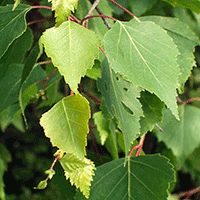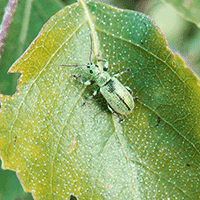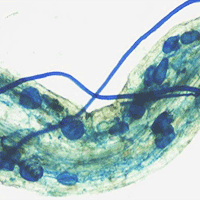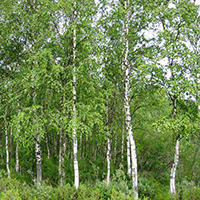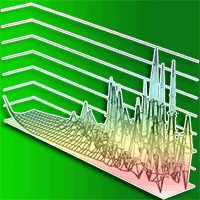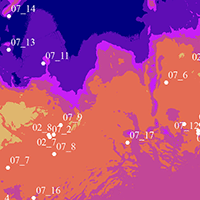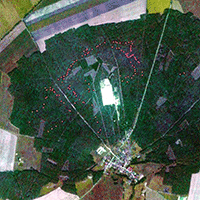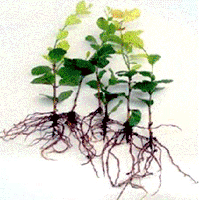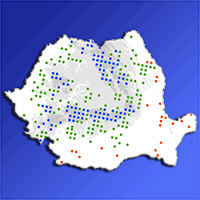One-year-old silver birch (Betula pendula Roth) saplings were subjected to artificial insect damage and defoliations of varying intensities, and subsequent growth indexes, biomass allocation patterns and photosynthesis were monitored during a 60-day period. Seven treatments were conducted in which the leaves of saplings were perforated with three or six holes per each leaf, and damaged by clipping one-third of each leaf, or they received 25, 50 and 75% defoliations during a single growing season (from April to August of 2014). Simulated insect damage and artificial defoliation decreased growth. The 75% defoliation significantly reduced the total dry mass of birch saplings at harvest by 30%, while such reduction did not influence the total productivity. The dry mass of leaves was reduced by 45% when saplings were defoliated by 75% compared to not defoliated saplings. Moreover, the total production of leaves significantly increased in the 75% defoliated saplings compared with control saplings. Artificial defoliation increased the relative biomass allocation to foliage, and this was more evident in defoliated than in mechanically insect-damaged saplings. Despite losing 25, 50 or 75% of leaf mass due to clipping, defoliated birch saplings recovered similar dry masses and root/shoot ratios by harvest as the non-defoliated saplings. Perforation and clipping parts of the leaves, as well as the artificial defoliations, caused the regrowth of biomass that did not significantly change compared to healthy silver birch saplings, and this phenomenon could be assessed as equal-compensatory growth.
Keywords
, , ,
Citation
Varnagiryte-Kabašinskiene I, Araminiene V, Stakenas V (2015). Effects of artificial defoliation and simulated insect damage on the growth of Betula pendula saplings. iForest 9: 95-100. - doi: 10.3832/ifor1522-008
Academic Editor
Massimo Faccoli
Paper history
Received: Dec 04, 2014
Accepted: Mar 10, 2015
First online: Jul 15, 2015
Publication Date: Feb 21, 2016
Publication Time: 4.23 months
© SISEF - The Italian Society of Silviculture and Forest Ecology 2015
Open Access
This article is distributed under the terms of the Creative Commons Attribution-Non Commercial 4.0 International (https://creativecommons.org/licenses/by-nc/4.0/), which permits unrestricted use, distribution, and reproduction in any medium, provided you give appropriate credit to the original author(s) and the source, provide a link to the Creative Commons license, and indicate if changes were made.

Breakdown by View Type
(Waiting for server response...)
Article Usage
Total Article Views: 50861
(from publication date up to now)
Breakdown by View Type
HTML Page Views: 43013
Abstract Page Views: 2810
PDF Downloads: 3796
Citation/Reference Downloads: 26
XML Downloads: 1216
Web Metrics
Days since publication: 3805
Overall contacts: 50861
Avg. contacts per week: 93.57
Article Citations
Article citations are based on data periodically collected from the Clarivate Web of Science web site
(last update: Mar 2025)
Total number of cites (since 2016): 4
Average cites per year: 0.40
Publication Metrics
by Dimensions ©
Articles citing this article
List of the papers citing this article based on CrossRef Cited-by.
(1)
Anttonen S, Piispanen R, Ovaska J, Mutikainen P, Saranpää P, Vapaavuori E (2002)Effects of defoliation on growth, biomass allocation, and wood properties of
Betula pendula clones grown at different nutrient levels. Canadian Journal of Forest Research 32: 498-508.
CrossRef |
Gscholar
(2)
Augner M, Tuomi J, Rousi M (1997)Effects of defoliation on competitive interactions in European white birch. Ecology 78: 2369-2377.
CrossRef |
Gscholar
(3)
Belsky AJ (1986)Does herbivory benefit plants? A review of the evidence. American Naturalist 127: 870-892.
CrossRef |
Gscholar
(4)
Danckwerts JE (1993)Reserve carbon and photosynthesis: their role in regrowth of
Themeda triandra, a widely distributed subtropical graminaceous species. Functional Ecology 7: 634-641.
CrossRef |
Gscholar
(5)
Eissenstat D, Duncan LW (1992)Root growth and carbohydrate responses in bearing citrus trees following partial canopy removal. Tree Physiology 10: 245-257.
CrossRef |
Gscholar
(6)
Ferraro DO, Oesterheld M (2002)Effect of defoliation on grass growth. A quantitative review. Oikos 98: 125-133.
CrossRef |
Gscholar
(7)
Hartley SE, Lawton JH (1987)The effects of different types of damage on chemistry of birch foliage and the responses of birch feeding insects. Oecologia 74: 432-437.
CrossRef |
Gscholar
(8)
Hjälten J, Danell K, Ericson L (1993)Effects of simulated herbivory and intraspecific competition on the compensatory ability of birches. Ecology 74: 1136-1142.
CrossRef |
Gscholar
(9)
Honkanen T, Haukioja E, Suomela J (1994)Effects of simulated defoliation and debudding on needle and shoot growth in Scots pine (
Pinus sylvestris): implications of plant source/sink relationships for plant-herbivore studies. Functional Ecology 8: 631-639.
CrossRef |
Gscholar
(10)
Hoogesteger J, Karlsson PS (1992)Effects of defoliation on radial stem growth and photosynthesis in the mountain birch (
Betula pubescens ssp.
tortuosa). Functional Ecology 6: 317-323.
CrossRef |
Gscholar
(11)
Huttunen L, Ayres MP, Niemelä P, Heiska S, Tegelberg R, Rousi M, Kellomäki S (2013)Interactive effects of defoliation and climate change on compensatory growth of silver birch seedlings. Silva Fennica 47 (3): article id 964, pp. 14.
CrossRef |
Gscholar
(12)
Huttunen L, Niemelä P, Peltola H, Heiska S, Rousi M, Kellomäki S (2007)Is a defoliated silver birch seedling able to overcompensate the growth under changing climate? Environmental and Experimental Botany 60: 227-238.
CrossRef |
Gscholar
(13)
Jacquet JS, Orazio C, Jactel H (2012)Defoliation by processionary moth significantly reduces tree growth: a quantitative review. Annals of Forest Science 69: 857-866.
CrossRef |
Gscholar
(14)
Landhäusser SM, Lieffers VJ (2012)Defoliation increases risk of carbon starvation in root systems of mature aspen. Trees 26: 653-666.
CrossRef |
Gscholar
(15)
Lyytikainen P (1994)Effects of natural and artificial defoliation on sawfly performance and foliar chemistry of Scots pine saplings. Annales Zoologici Fennici 31: 307-318.
Online |
Gscholar
(16)
Markkola A, Kuikka K, Rautio P, Härmä E, Roitto M, Tuomi J (2004)Defoliation increases carbon limitation in ectomycorrhizal symbiosis of
Betula pubescens. Oecologia 140: 234-240.
CrossRef |
Gscholar
(17)
Maschinski J, Whitman TG (1989)The continuum of plant responses to herbivory: the influence of plant association, nutrient availability, and timing. American Naturalist 134: 1-19.
CrossRef |
Gscholar
(18)
McGraw JB, Gottschalk KW, Vaver MC, Chester AL (1990)Interactive effects of resource availabilities and defoliation on photosynthesis, growth, and mortality of red oak seedlings. Tree Physiology 7: 247-254.
CrossRef |
Gscholar
(19)
McNaughton SJ (1986)On plant and herbivores. American Naturalist 128: 765-770.
CrossRef |
Gscholar
(20)
Meyer GA (1998)Mechanisms promoting recovery from defoliation in goldenrod (
Solidago altissima). Canadian Journal of Botany 76: 450-459.
CrossRef |
Gscholar
(21)
Mutikainen P, Walls M, Ovaska J, Keinänen M, Julkunen-Tiitto R, Vapaavuori E (2000)Herbivore resistance in
Betula pendula: effect of fertilization, defoliation and plant genotype. Ecology 81: 49-65.
CrossRef |
Gscholar
(22)
Oesterheld M (1992)Effect of defoliation intensity on aboveground and belowground relative growth rates. Oecologia 92: 313-316.
CrossRef |
Gscholar
(23)
Oesterheld M, McNaughton SJ (1988)Intraspecific variation in the response of
Themeda triandra to defoliation. The effect of time of recovery and growth rates on compensatory growth. Oecologia 77: 181-186.
CrossRef |
Gscholar
(24)
Oesterheld M, McNaughton SJ (1991)Effect of stress and time for recovery on the amount of compensatory growth after grazing. Oecologia 85: 305-313.
CrossRef |
Gscholar
(25)
Osier TL, Lindroth RL (2004)Long-term effects of defoliation on quaking aspen in relation to genotype and nutrient availability: plant growth, phytochemistry and insect performance. Oecologia 139: 55-65.
CrossRef |
Gscholar
(26)
Reich PB, Walters MB, Krause SC, Vanderklein DW, Raffa KF, Tabone T (1993)Growth, nutrition and gas exchange of
Pinus resinosa following artificial defoliation. Trees 7: 67-77.
CrossRef |
Gscholar
(27)
Schat M, Blossey B (2005)Influence of natural and simulated leaf beetle herbivory on biomass allocation and plant architecture of purple loosestrife (
Lythrum salicaria L.). Environmental Entomology 34 (4): 906-914.
CrossRef |
Gscholar
(28)
Stevens MT, Kruger EL, Lindroth RL (2008)Variation in tolerance to herbivory is mediated by differences in biomass allocation in aspen. Functional Ecology 22: 40-47.
CrossRef |
Gscholar
(29)
Thomson VP, Cunningham SA, Ball MC, Nicotra AB (2003)Compensation for herbivory by
Cucumis sativus through increased photosynthetic capacity and efficiency. Oecologia 134: 167-175.
CrossRef |
Gscholar
(30)
Zangerl AR, Arntz AM, Berenbaum MR (1997)Physiological price of an induced chemical defence: photosynthesis, respiration, biosynthesis, and growth. Oecologia 109: 433-441.
CrossRef |
Gscholar
(31)
Zhao W, Chen SP, Lin GH (2008)Compensatory growth responses to clipping defoliation in
Leymus chinensis (Poaceae) under nutrient addition and water deficiency conditions. Plant Ecology 196: 85-99.
CrossRef |
Gscholar
